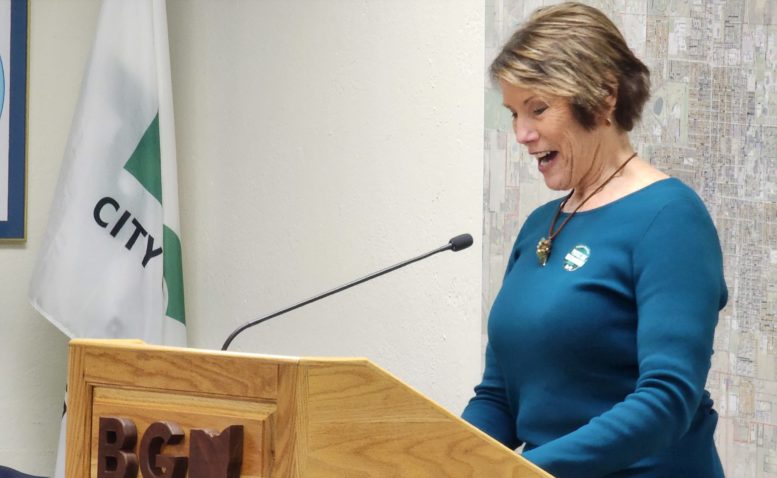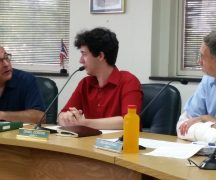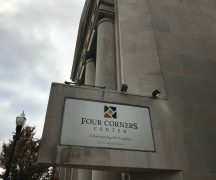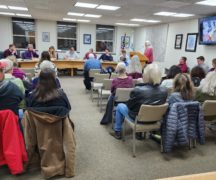By JAN LARSON McLAUGHLIN
BG Independent News
Bowling Green residents wanting to protect their older neighborhoods again voiced concerns to City Council Monday evening. Given the customary two-minute speaking limits, this time several residents ceded their precious seconds to Emily Dunipace – the anointed spokesperson against a zoning code change that could lead to more rental housing and businesses in the city’s older residential neighborhoods.
Dunipace, who lives in a historic home on West Wooster Street, noted that the 2020 U.S. Census found that 64% of the homes in Bowling Green were non-owner occupied. City leaders should be concerned about Bowling Green’s status as one of the top three communities in Ohio with nearly two-thirds of the homes being rentals, Dunipace said.
“This is a huge red flag,” she said. “They lower the home values. They restrict the number of homes for purchase.”
Unlike owner-occupied homes, “rental properties are businesses,” Dunipace said. “The rental industry in Bowling Green is robust.”
In addition to the PR zoning allowing some businesses to locate in residential neighborhoods, the zoning also relaxes restrictions on duplexes. Dunipace said it isn’t fair to burden the historic neighborhoods bordering both sides of Main Street with more challenges, bringing “continued devaluation of our property values.”
“I know that it is necessary for zoning codes to be updated,” she said to City Council. “I am asking you to consider all aspects. I am asking you to listen” to homeowners in the historic neighborhoods. “There are not very many of us left.”
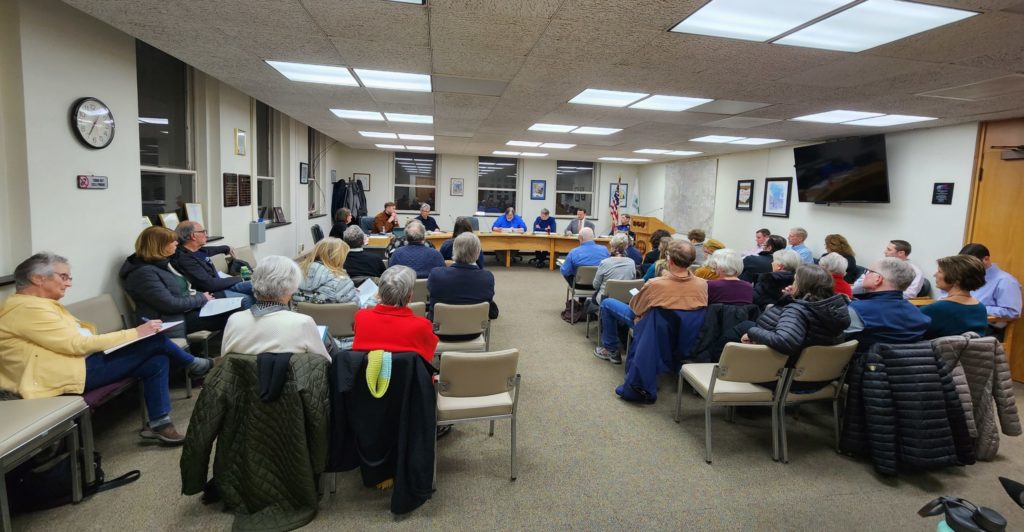
Several of those attending City Council wore stickers saying “Save Our Neighborhoods.”
The fear, according to materials passed out in the community by the citizen group, is that the PR zoning will allow businesses next to homes, reduce lot sizes, decrease the number of single-family homes, add rental units, reduce home property values, increase population density and parking problems, deteriorate quality of life, result in fewer trees and smaller yards, and draw customers from downtown businesses.
Also speaking against the zoning change was Jack Santino, who lives on Buttonwood Avenue, part of the proposed PR district.
“I believe everybody on council and in the room wants to do what’s best for Bowling Green,” Santino said. But the PR zoning would have the opposite effect.
“The quality of life we now enjoy would be radically changed,” he said.
The zoning change would hurt downtown businesses, and bring a more transient population to the neighborhoods. The businesses locating next to homes aren’t going to be “mom and pop” groceries, Santino said.
When families move to communities, they want to know the quality of the schools – not if there’s a chain coffee store next door, he said.
Santino suggested that City Council permanently table the PR zoning category. “No shame, no blame,” he said.
David Drain, who lives in a historic home on East Court Street, told council that 547 signatures have been collected on a petition opposing the zoning change. The petition was not given to council.
Joe DeMare, who lives on South Main Street, voiced concerns about the lack of vision shown when the old junior high and National Guard Armory were torn down rather than converted into apartments.
“There are a lot of missed opportunities here in Bowling Green,” DeMare said.
Penny Evans-Meyer, of Buttonwood Avenue, said zoning codes are intended to preserve the positive parts of communities.
“These neighborhoods offer much to be preserved,” she said, listing the old houses, shade trees and sidewalks. “We want our oldest parts of the community to survive.”
Joyce Kepke, who lives on Lyn Road, said she first raised her concerns about the PR zoning to city planning officials 18 months ago. She continues to repeat her concerns about the effects on the older neighborhoods.
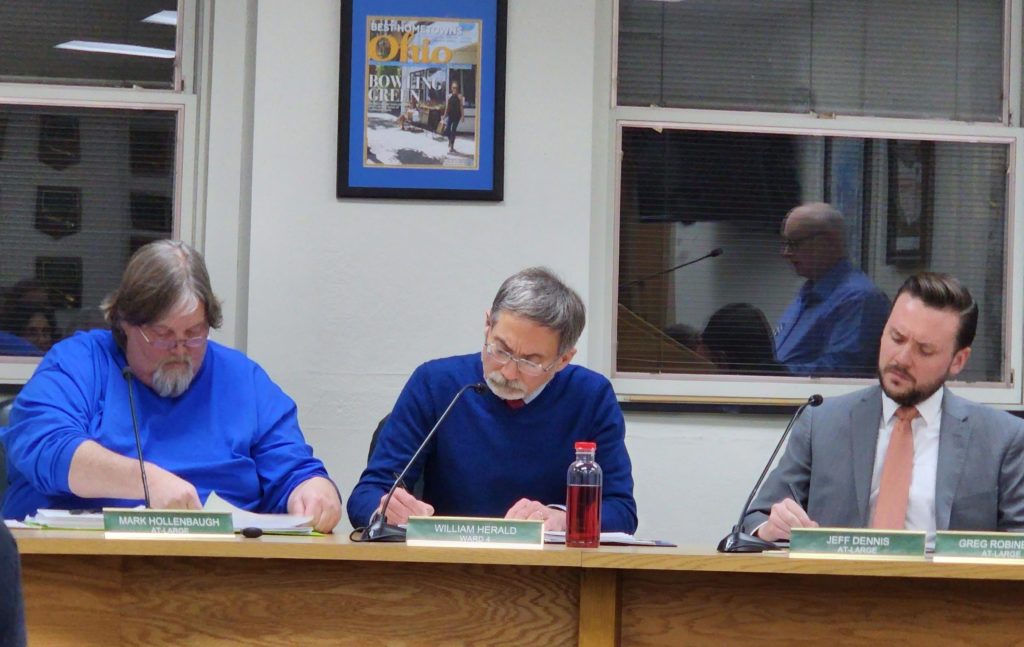
In response to questions received earlier from citizens, City Council President Mark Hollenbaugh read a statement Monday evening explaining some of what led to the proposed zoning update, and a general timeline expected for the changes.
Hollenbaugh predicted a new draft of the zoning code will be posted on the city’s website sometime this month. A community forum on the controversial Pedestrian Residential zoning will be held sometime in March.
The city’s current zoning code was originally adopted in 1975.
“A reflection of the time it was written, our old code is based on dated ideas of our community’s needs and values,” Hollenbaugh said. “The code is also complicated and confusing for users.”
The city’s 2014 Future Land Use Plan called for “traditional residential” with some retail permitted in the neighborhoods surrounding downtown, he said. That plan and the 2018 Community Action Plan called for more diverse housing options in neighborhoods adjacent to the downtown and citywide.
“These planning documents are driving the goals for the PR District, which are to maintain and preserve the walkable neighborhoods surrounding downtown by allowing limited types of small businesses and more diverse housing options,” Hollenbaugh said.
Public comments have been accepted throughout the process, he added.
“Our city has been working on this project for many years and there has been a lot of public engagement around these issues,” he said. “Our city’s planning documents are driving the changes to the code. I recognize, however, that the zoning code is where the rubber meets the road and that it provides a level of detail that was not in our planning documents, and I thank everyone for their involvement and attention to the drafts so far. And I look forward to more discussion on the PR District and the whole code once we receive a clean draft this month.”

